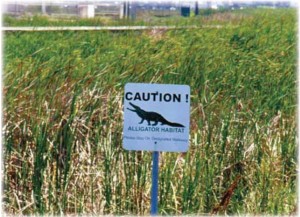Florida Environmental Resources Permit
Florida has the most aggressive state-level program of the Gulf Coast States. Florida implements a state permitting program which operates independently of the federal §404 program. Applicants must obtain both a state and §404 permit. The Florida Environmental Resources Permit (ERP) Program is administered jointly by the Florida Department of Environmental Protection (FLDEP) and four of the five regional Water Management Districts (WMDs). (ELI, 2006). The program, which is in effect throughout the state (except for the Florida panhandle), regulates activities involving the alteration of surface water flows, including new activities in uplands that generate stormwater runoff from upland construction, as well as dredging and filling in wetlands and other surface waters. The basic ERP permit standard is “that activities must not adversely impact water resources, including water quality, water quantity, and the value of functions provided to fish and wildlife and listed species by wetlands and other surface waters” (ELI, 2006).
The Florida wetlands program regulates “any dredging, filling, or construction in, on, or over waters and wetlands that are connected, either naturally or artificially, to ‘named waters,’” which include the Gulf of Mexico, estuaries, and lagoons. Permit applications are initially sent to the FLDEP, applicable WMD, or delegated local government.
Permits that cannot be entirely processed by the state are forward to the Corps. From this point, the permitting processes proceed independently. The issuance of an ERP serves as the state’s water quality (§ 401) consistency certification and/ or waiver. The Corps, therefore, cannot issue a §404 permit until the project has received the state permit.
What makes Florida’s Wetland Permit Program Different?
The Florida program is distinctive in that it is broader than the federal program, because it regulates the alteration of uplands that may affect surface water flows and “isolated” wetlands falling outside of federal jurisdiction. Florida regulates all land disturbance that could have an effect on state waters, whether or not the activity itself occurs in state waters. From a sea level rise adaptation perspective, this kind of scope could enable Florida to provide protection to dry, potentially inundatable lands, although there is no indication that they are doing so now.
The other interesting aspect of the Florida framework is that it allows for much more regionalization and local participation. The regionalization of the program – the involvement of the regional water management districts, in particular – is also unique and no doubt would contribute to greater adaptive capacity if policy was developed to deal with climate change impacts on coastal wetlands. The regional water management districts often take a broader watershed approach to environmental management. Such an approach could certainly engender more strategic thinking in terms of protecting wetlands affected by sea level rise, were the officials sufficiently informed and motivated to do so. In addition, the Florida program allows for delegation to local authorities under certain circumstances, although to date only Broward County and more recently Hillsborough County have received full delegation, and Miami-Dade county have received partial delegation.
One key piece of legislation that could give Florida significant ability to manage climate change impacts on coastal wetlands is the Florida Areas of Critical State Concern (ACSC) Law (FS 380.05). This law gives the state planning agency, the Division of Community Planning, the ability to establish ACSCs based on unique habitat or cultural value and the nature of the threat that may be endangering these areas. Seven such areas have been established in Florida. The DCP can recommend purchase of state lands in these areas, and has the power to review local and regional plans that could affect the ACSCs. In theory, at least, the DCP could recommend the purchase of (or prohibit development on) low-lying uplands likely to be inundated in the future inland from ACSCs that included estuarine wetlands.




